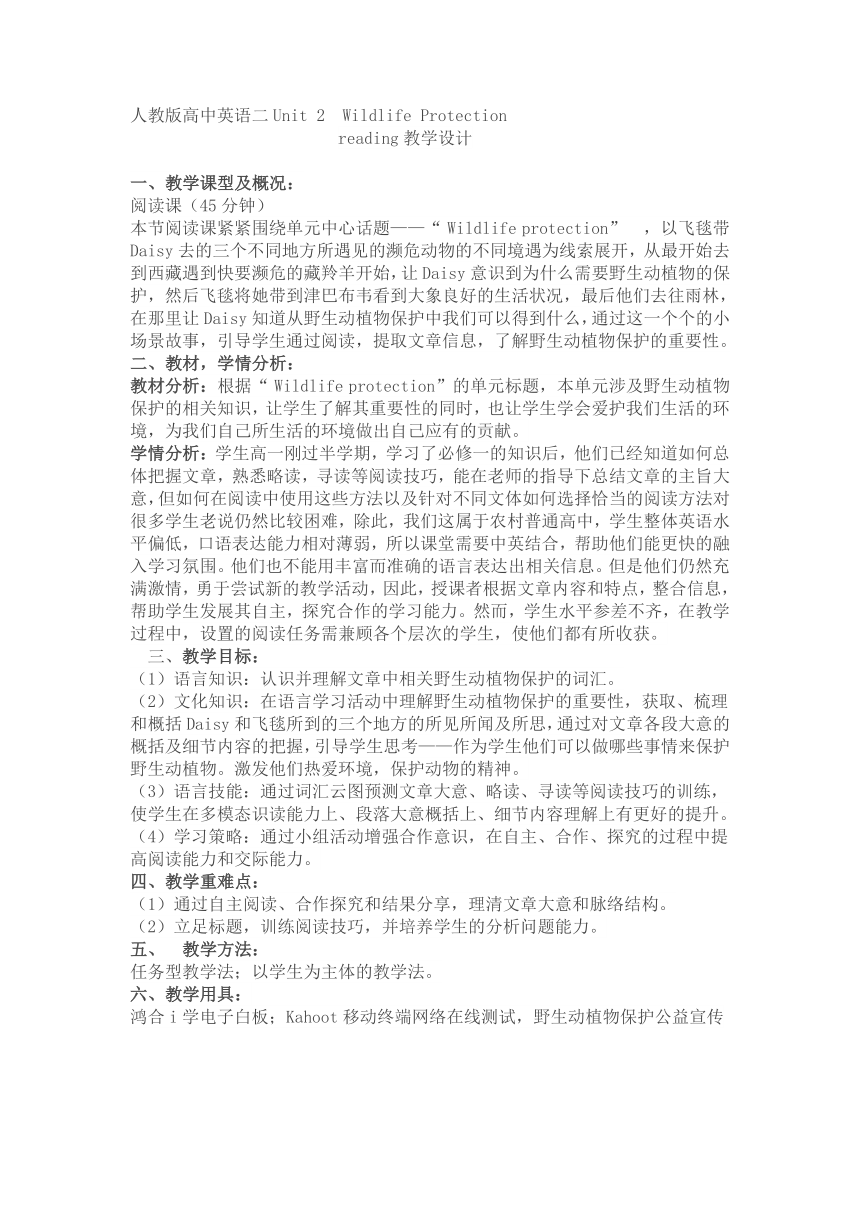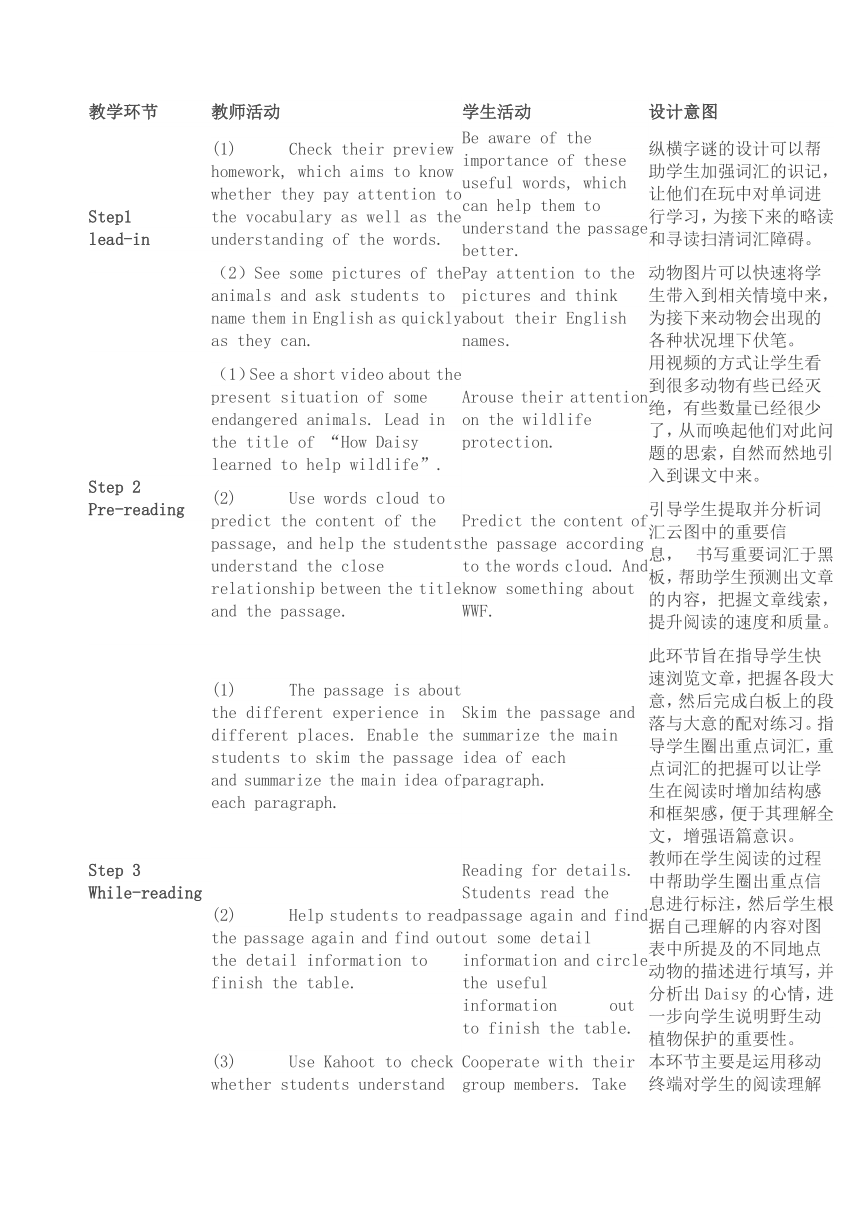人教版(2019)必修 第二册 Unit 2Unit 2 Wildlife Protection reading 教学设计(表格式)
文档属性
| 名称 | 人教版(2019)必修 第二册 Unit 2Unit 2 Wildlife Protection reading 教学设计(表格式) |

|
|
| 格式 | doc | ||
| 文件大小 | 38.0KB | ||
| 资源类型 | 教案 | ||
| 版本资源 | 人教版(2019) | ||
| 科目 | 英语 | ||
| 更新时间 | 2024-10-04 14:08:52 | ||
图片预览


文档简介
人教版高中英语二Unit 2 Wildlife Protection
reading教学设计
一、教学课型及概况:
阅读课(45分钟)
本节阅读课紧紧围绕单元中心话题——“ Wildlife protection” ,以飞毯带Daisy去的三个不同地方所遇见的濒危动物的不同境遇为线索展开,从最开始去到西藏遇到快要濒危的藏羚羊开始,让Daisy意识到为什么需要野生动植物的保护,然后飞毯将她带到津巴布韦看到大象良好的生活状况,最后他们去往雨林,在那里让Daisy知道从野生动植物保护中我们可以得到什么,通过这一个个的小场景故事,引导学生通过阅读,提取文章信息,了解野生动植物保护的重要性。
二、教材,学情分析:
教材分析:根据“ Wildlife protection”的单元标题,本单元涉及野生动植物保护的相关知识,让学生了解其重要性的同时,也让学生学会爱护我们生活的环境,为我们自己所生活的环境做出自己应有的贡献。
学情分析:学生高一刚过半学期,学习了必修一的知识后,他们已经知道如何总体把握文章,熟悉略读,寻读等阅读技巧,能在老师的指导下总结文章的主旨大意,但如何在阅读中使用这些方法以及针对不同文体如何选择恰当的阅读方法对很多学生老说仍然比较困难,除此,我们这属于农村普通高中,学生整体英语水平偏低,口语表达能力相对薄弱,所以课堂需要中英结合,帮助他们能更快的融入学习氛围。他们也不能用丰富而准确的语言表达出相关信息。但是他们仍然充满激情,勇于尝试新的教学活动,因此,授课者根据文章内容和特点,整合信息,帮助学生发展其自主,探究合作的学习能力。然而,学生水平参差不齐,在教学过程中,设置的阅读任务需兼顾各个层次的学生,使他们都有所收获。
三、教学目标:
(1)语言知识:认识并理解文章中相关野生动植物保护的词汇。
(2)文化知识:在语言学习活动中理解野生动植物保护的重要性,获取、梳理和概括Daisy和飞毯所到的三个地方的所见所闻及所思,通过对文章各段大意的概括及细节内容的把握,引导学生思考——作为学生他们可以做哪些事情来保护野生动植物。激发他们热爱环境,保护动物的精神。
(3)语言技能:通过词汇云图预测文章大意、略读、寻读等阅读技巧的训练,使学生在多模态识读能力上、段落大意概括上、细节内容理解上有更好的提升。
(4)学习策略:通过小组活动增强合作意识,在自主、合作、探究的过程中提高阅读能力和交际能力。
四、教学重难点:
(1)通过自主阅读、合作探究和结果分享,理清文章大意和脉络结构。
(2)立足标题,训练阅读技巧,并培养学生的分析问题能力。
五、 教学方法:
任务型教学法;以学生为主体的教学法。
六、教学用具:
鸿合i学电子白板;Kahoot移动终端网络在线测试,野生动植物保护公益宣传
教学环节 教师活动 学生活动 设计意图
Step1
lead-in
(1) Check their preview homework, which aims to know whether they pay attention to the vocabulary as well as the understanding of the words. Be aware of the importance of these useful words, which can help them to understand the passage better. 纵横字谜的设计可以帮助学生加强词汇的识记,让他们在玩中对单词进行学习,为接下来的略读和寻读扫清词汇障碍。
(2)See some pictures of the animals and ask students to name them in English as quickly as they can. Pay attention to the pictures and think about their English names. 动物图片可以快速将学生带入到相关情境中来,为接下来动物会出现的各种状况埋下伏笔。
Step 2
Pre-reading (1)See a short video about the present situation of some endangered animals. Lead in the title of “How Daisy learned to help wildlife”. Arouse their attention on the wildlife protection. 用视频的方式让学生看到很多动物有些已经灭绝,有些数量已经很少了,从而唤起他们对此问题的思索,自然而然地引入到课文中来。
(2) Use words cloud to predict the content of the passage, and help the students understand the close relationship between the title and the passage.
Predict the content of the passage according to the words cloud. And know something about WWF. 引导学生提取并分析词汇云图中的重要信息, 书写重要词汇于黑板,帮助学生预测出文章的内容,把握文章线索,提升阅读的速度和质量。
Step 3
While-reading (1) The passage is about the different experience in different places. Enable the students to skim the passage and summarize the main idea of each paragraph. Skim the passage and summarize the main idea of each paragraph. 此环节旨在指导学生快速浏览文章,把握各段大意,然后完成白板上的段落与大意的配对练习。指导学生圈出重点词汇,重点词汇的把握可以让学生在阅读时增加结构感和框架感,便于其理解全文,增强语篇意识。
(2) Help students to read the passage again and find out the detail information to finish the table. Reading for details. Students read the passage again and find out some detail information and circle the useful information out to finish the table. 教师在学生阅读的过程中帮助学生圈出重点信息进行标注,然后学生根据自己理解的内容对图表中所提及的不同地点动物的描述进行填写,并分析出Daisy的心情,进一步向学生说明野生动植物保护的重要性。
(3) Use Kahoot to check whether students understand the passage better. And for each question, if they don’t get satisfied results, I will explain it to the students one by one. Here are 13 questions for them---8 questions for True or False and 5 questions for multiple choices. Cooperate with their group members. Take out their smartphone to do the online quiz. They should pay attention to the questions on the screen and choose the right answers on the smartphone in a limited time. For each question they will get a score, if they choose the answers quicker and righter than others, their group’s score will be higher. So they need to cooperate with each other better. 本环节主要是运用移动终端对学生的阅读理解状况进行在线测试,学生需要小组合作完成本环节,题目会出现在电子白板上,学生手机上只显示答案的图标,选的又对又快的组将会得到比较高的分数,每题都会自动显示答题的状况,错误率比较高的题目老师可以进行详细的讲解,这样对学生哪里还不太懂,哪里理解的不透彻会有很好的把握,然后根据需要逐一解决。帮助学生加深对文章的理解。
Step 4
Post-reading In order to emphasize the awareness of the wildlife protection, the teacher asks students to do the group discussion “what should we do to protect the wildlife”. Then, work in groups and make presentation. Work in groups and discus “what should we do to protect the wildlife”. Students will write down some useful sentences or phrases. And then, some group will share their group idea with others. Through this students will know how to live with our environment. And they will cherish their present lives and show their great devotion to the nature. 根据已学的文章内容,对学生提出进一步的要求,让他们进行小组讨论,作为学生,“我们应该做些什么来保护野生动植物”,让学生在文章理解的基础上进行自我的印象加深,让他们意识到可以从自身,从身边的小事情做起来保护我们生活的环境,同时也让他们意识到环境和动物于我们人类而言的重要性,让他们学会和周围的事,物和谐相处,让他们学会热爱自然,热爱环境。
Step 5
Homework After the discussion, the teacher will ask the students to reorganize their ideas and put them into sentences and finally form an article about “what should we do to protect the wildlife”. After the class, students should reorganize their ideas and put them into an article. It can help them to improve their writing skills. 本环节主要是想通过将学生所讨论的内容及时进行加工整理,生成文字性完整的东西,学生不但能较好的深挖文章的内涵,同时也可以对自己英语作文的写作有所帮助。
八、板书设计
Unit 2 Wildlife Protection
Reading
wildlife need
decrease animals
food protection
die number
reading教学设计
一、教学课型及概况:
阅读课(45分钟)
本节阅读课紧紧围绕单元中心话题——“ Wildlife protection” ,以飞毯带Daisy去的三个不同地方所遇见的濒危动物的不同境遇为线索展开,从最开始去到西藏遇到快要濒危的藏羚羊开始,让Daisy意识到为什么需要野生动植物的保护,然后飞毯将她带到津巴布韦看到大象良好的生活状况,最后他们去往雨林,在那里让Daisy知道从野生动植物保护中我们可以得到什么,通过这一个个的小场景故事,引导学生通过阅读,提取文章信息,了解野生动植物保护的重要性。
二、教材,学情分析:
教材分析:根据“ Wildlife protection”的单元标题,本单元涉及野生动植物保护的相关知识,让学生了解其重要性的同时,也让学生学会爱护我们生活的环境,为我们自己所生活的环境做出自己应有的贡献。
学情分析:学生高一刚过半学期,学习了必修一的知识后,他们已经知道如何总体把握文章,熟悉略读,寻读等阅读技巧,能在老师的指导下总结文章的主旨大意,但如何在阅读中使用这些方法以及针对不同文体如何选择恰当的阅读方法对很多学生老说仍然比较困难,除此,我们这属于农村普通高中,学生整体英语水平偏低,口语表达能力相对薄弱,所以课堂需要中英结合,帮助他们能更快的融入学习氛围。他们也不能用丰富而准确的语言表达出相关信息。但是他们仍然充满激情,勇于尝试新的教学活动,因此,授课者根据文章内容和特点,整合信息,帮助学生发展其自主,探究合作的学习能力。然而,学生水平参差不齐,在教学过程中,设置的阅读任务需兼顾各个层次的学生,使他们都有所收获。
三、教学目标:
(1)语言知识:认识并理解文章中相关野生动植物保护的词汇。
(2)文化知识:在语言学习活动中理解野生动植物保护的重要性,获取、梳理和概括Daisy和飞毯所到的三个地方的所见所闻及所思,通过对文章各段大意的概括及细节内容的把握,引导学生思考——作为学生他们可以做哪些事情来保护野生动植物。激发他们热爱环境,保护动物的精神。
(3)语言技能:通过词汇云图预测文章大意、略读、寻读等阅读技巧的训练,使学生在多模态识读能力上、段落大意概括上、细节内容理解上有更好的提升。
(4)学习策略:通过小组活动增强合作意识,在自主、合作、探究的过程中提高阅读能力和交际能力。
四、教学重难点:
(1)通过自主阅读、合作探究和结果分享,理清文章大意和脉络结构。
(2)立足标题,训练阅读技巧,并培养学生的分析问题能力。
五、 教学方法:
任务型教学法;以学生为主体的教学法。
六、教学用具:
鸿合i学电子白板;Kahoot移动终端网络在线测试,野生动植物保护公益宣传
教学环节 教师活动 学生活动 设计意图
Step1
lead-in
(1) Check their preview homework, which aims to know whether they pay attention to the vocabulary as well as the understanding of the words. Be aware of the importance of these useful words, which can help them to understand the passage better. 纵横字谜的设计可以帮助学生加强词汇的识记,让他们在玩中对单词进行学习,为接下来的略读和寻读扫清词汇障碍。
(2)See some pictures of the animals and ask students to name them in English as quickly as they can. Pay attention to the pictures and think about their English names. 动物图片可以快速将学生带入到相关情境中来,为接下来动物会出现的各种状况埋下伏笔。
Step 2
Pre-reading (1)See a short video about the present situation of some endangered animals. Lead in the title of “How Daisy learned to help wildlife”. Arouse their attention on the wildlife protection. 用视频的方式让学生看到很多动物有些已经灭绝,有些数量已经很少了,从而唤起他们对此问题的思索,自然而然地引入到课文中来。
(2) Use words cloud to predict the content of the passage, and help the students understand the close relationship between the title and the passage.
Predict the content of the passage according to the words cloud. And know something about WWF. 引导学生提取并分析词汇云图中的重要信息, 书写重要词汇于黑板,帮助学生预测出文章的内容,把握文章线索,提升阅读的速度和质量。
Step 3
While-reading (1) The passage is about the different experience in different places. Enable the students to skim the passage and summarize the main idea of each paragraph. Skim the passage and summarize the main idea of each paragraph. 此环节旨在指导学生快速浏览文章,把握各段大意,然后完成白板上的段落与大意的配对练习。指导学生圈出重点词汇,重点词汇的把握可以让学生在阅读时增加结构感和框架感,便于其理解全文,增强语篇意识。
(2) Help students to read the passage again and find out the detail information to finish the table. Reading for details. Students read the passage again and find out some detail information and circle the useful information out to finish the table. 教师在学生阅读的过程中帮助学生圈出重点信息进行标注,然后学生根据自己理解的内容对图表中所提及的不同地点动物的描述进行填写,并分析出Daisy的心情,进一步向学生说明野生动植物保护的重要性。
(3) Use Kahoot to check whether students understand the passage better. And for each question, if they don’t get satisfied results, I will explain it to the students one by one. Here are 13 questions for them---8 questions for True or False and 5 questions for multiple choices. Cooperate with their group members. Take out their smartphone to do the online quiz. They should pay attention to the questions on the screen and choose the right answers on the smartphone in a limited time. For each question they will get a score, if they choose the answers quicker and righter than others, their group’s score will be higher. So they need to cooperate with each other better. 本环节主要是运用移动终端对学生的阅读理解状况进行在线测试,学生需要小组合作完成本环节,题目会出现在电子白板上,学生手机上只显示答案的图标,选的又对又快的组将会得到比较高的分数,每题都会自动显示答题的状况,错误率比较高的题目老师可以进行详细的讲解,这样对学生哪里还不太懂,哪里理解的不透彻会有很好的把握,然后根据需要逐一解决。帮助学生加深对文章的理解。
Step 4
Post-reading In order to emphasize the awareness of the wildlife protection, the teacher asks students to do the group discussion “what should we do to protect the wildlife”. Then, work in groups and make presentation. Work in groups and discus “what should we do to protect the wildlife”. Students will write down some useful sentences or phrases. And then, some group will share their group idea with others. Through this students will know how to live with our environment. And they will cherish their present lives and show their great devotion to the nature. 根据已学的文章内容,对学生提出进一步的要求,让他们进行小组讨论,作为学生,“我们应该做些什么来保护野生动植物”,让学生在文章理解的基础上进行自我的印象加深,让他们意识到可以从自身,从身边的小事情做起来保护我们生活的环境,同时也让他们意识到环境和动物于我们人类而言的重要性,让他们学会和周围的事,物和谐相处,让他们学会热爱自然,热爱环境。
Step 5
Homework After the discussion, the teacher will ask the students to reorganize their ideas and put them into sentences and finally form an article about “what should we do to protect the wildlife”. After the class, students should reorganize their ideas and put them into an article. It can help them to improve their writing skills. 本环节主要是想通过将学生所讨论的内容及时进行加工整理,生成文字性完整的东西,学生不但能较好的深挖文章的内涵,同时也可以对自己英语作文的写作有所帮助。
八、板书设计
Unit 2 Wildlife Protection
Reading
wildlife need
decrease animals
food protection
die number
